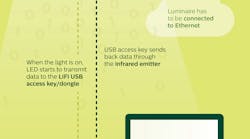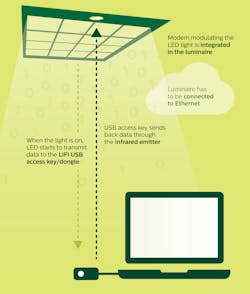Sponsored
One of the next technological waves that may crash down on the lighting market is LiFi (Light Fidelity), which transmits data over light waves instead of radio frequency waves.
First developed in 2011 by Scottish scientist Harald Haas at the University Edinburgh, LiFi has captured the imagination of technologists in the lighting industry because of its potential to one day transmit data much faster than WiFi; its utilization of the visible light spectrum instead of the ever-more crowded radio frequency spectrum; and its secure transmission of data.
Haas is world-renowned for LiFi research and for the LiFi products being developed by PureLiFi, the company he cofounded in 2012. According to www.purelifi.com, his talk at TED Global 2011, “Wireless Data from Every Light Bulb,” has been watched online more than 2.5 million times.
According to that TED video and information on the website, Haas saw that the radio frequency spectrum was getting very crowded because of the explosion in cellphones and wireless devices and that it needed more real estate. He discovered that the visible light spectrum had plenty of unused capacity and could offer communications at blazing-fast speeds, very securely. Data being transmitted by light waves only travels as far as the area a LED fixture illuminates, making it a natural technology choice for applications requiring data security, including hospitals and clinics, factories and banking.
LiFi-enabled lighting fixtures with LiFi modems are connected to networks via Ethernet cables and transmit data through the light waves to and from USB dongles (or access keys) connected to users’ personal computers, tablets or other devices. The dongles have LiFi transmitters and receivers.
PureLiFi execs have been active on LiFi standards committees and in 2016 the company launched a LiFi-enabled light fixture with partner Lucibel. Signify (Philips Lighting) (www.signify.com/global/innovation/lifi), and LumEfficient (www. lumefficient.com) are two other names to familiarize yourself with in the LiFi space. LumEfficient won the LightFair 2018’s Judges’ Citation Award for its LiFi technology and Signify launched its first LiFi product offering last year.
Ed Huibers, head of business development for Signify, discusses LiFi technology in a company video. “The radio spectrum is getting full. Instead of using radio waves, LiFi uses light waves to communicate,” he says in the Signify video. “And the bandwidth is big. Experts say it’s more than 1,000 times the size of the radio spectrum, so it will not get full anytime soon.
“LiFi is a great alternative for WiFi, especially where radio waves are not permitted or work poorly. Think of hospitals, clinics, the underground, planes and schools. And since light cannot penetrate walls, it can give you an additional layer of security for banks and government organizations.”
Huiber told Electrical Wholesaling in an email that Signify has seen multiple applications in industry, banks and healthcare where “on short term” LiFi is cost effective at solving an issue in communication or/and in security. He sees steep cost cuts and more specifications of LiFi products in the coming years. The medical, industrial and governmental applications will be the first to convert, he says.
With download speeds of well under 100 mbps (megabits per second), the data transmission speeds of existing LiFi-enabled fixtures aren’t yet enough to turn heads. But according to one Fast Company report, lab tests show the potential to reach speeds of up to 224 Gigabits per second, and PureLiFi has already demonstrated data download rates over 3 Gbps with a single blue micro-LED in the lab — 100 times faster than current download speeds of some existing LiFi fixtures.
Huibers said LiFi is a new technology that’s still ramping up. “Wireless data connectivity is important, as this is new technology. Of course, customers are testing and trying first before moving critical processes. New technology requires standardization for instance. This is ongoing.”
While it may be a while before LiFI fixtures make their way to shelves in distributors’ warehouses, it’s always important to familiarize yourself with the next game-changing technology.
Says Huibers of Signify, “On the product side, costs will have to move down, and standardization is important. As a leader of LiFi, we are continuing to work on it, as well as raise the awareness and knowledge of the distributor. Customers will come with new questions, and distributors will have to be equipped with the right answers.”
In his TED Global presentation, Haas of PureLiFi talked about how the lighting and wireless communications industries may be on a path to merge because of the way LEDs have changed the business and the introduction of LiFi.
“At the moment we have two independent players — the lighting industry and the wireless communications industry. The lighting industry at the moment has a problem. LEDs lasts for 20-30 years. The business model has changed from volume sales to lighting as a service (LAAS) business model.
“Like a mobile phone that delivers mobile telephony, a mobile phone also delivers thousands of services. In the future the light in the ceiling will have an operating system that delivers hundreds of services, including smart control of your environment, saving energy, applications in private homes, offices and industrial applications.
“Wireless communications has limited space in the radio frequency spectrum. They need more resources and to do that need to expand to into the visible lighting domain. You will have a wireless operator that also sells light bulbs. That is a disruption of two industries and it forms a new ‘superindustry’ that is the heart of the third industrial revolution.”
LiFi is a fascinating technology that isn’t quite ready for prime time, because of the speed and standards issues discussed in this article. However, the day may come when it rocks the lighting world, so keep an eye on it. The sidebar on this page offers some sources of information that will help you track how fast this technology is evolving.
Sidebar: LiFi’s Three Biggest Selling Points
Ed Huibers, head of business development for Signify, said LiFi shines in three areas:
Security – LiFi will not go through walls, which means the wireless connectivity stays in the building, adding additional safety and security to the network.
Stability – LiFi is very stable compared to radio-communication. In areas where radio communication is difficult (factories for instance) or very busy (multi-tenant offices) it offers an alternative connection.
Speed – LiFi is using light waves instead of radiowaves. In areas where radiowaves are not preferred, LiFi is a good alternative.
Sidebar:LiFi Resources for More Information
Looking for info on LiFi? Start with these sources:
MANUFACTURERS
LumEfficient
PureLiFi
Signify (Philips Lighting)
(www.signify.com/global/innovation/lifi)
OTHER GOOD SOURCES
EdisonReport
Randy Reid offers plenty of commentary on the latest developments in LiFi. He is also owner of LumEfficient, a provider of LiFi technology.
Get a Grip on Lighting podcasts
The interviews that hosts Michael Colligan and Greg Ehrich do with various lighting execs are always worth a listen.



